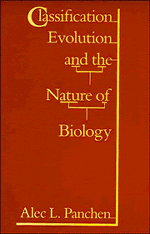Book contents
- Frontmatter
- Contents
- Acknowledgements
- CHAPTER 1 INTRODUCTION
- CHAPTER 2 PATTERNS OF CLASSIFICATION
- CHAPTER 3 PATTERNS OF PHYLOGENY
- CHAPTER 4 HOMOLOGY AND THE EVIDENCE FOR EVOLUTION
- CHAPTER 5 GEOLOGICAL AND GEOGRAPHICAL EVIDENCE
- CHAPTER 6 METHODS OF CLASSIFICATION: THE DEVELOPMENT OF TAXONOMY
- CHAPTER 7 METHODS OF CLASSIFICATION: PHENETICS AND CLADISTICS
- CHAPTER 8 METHODS OF CLASSIFICATION: THE CURRENT DEBATE
- CHAPTER 9 CLASSIFICATION AND THE RECONSTRUCION OF PHYLOGENY
- CHAPTER 10 IS SYSTEMATICS INDEPENDENT?
- CHAPTER 11 MECHANISMS OF EVOLUTION: DARWINSM AND ITS RIVALS
- CHAPTER 12 MECHANISMS OF EVOLUTION: THE SYNTHETIC THEORY
- CHAPTER 13 SCIENTIFIC KNOWLEDGE
- CHAPTER 14 PHILOSOPHY AND BIOLOGY
- References
- Author index
- Subject index
CHAPTER 9 - CLASSIFICATION AND THE RECONSTRUCION OF PHYLOGENY
Published online by Cambridge University Press: 03 May 2011
- Frontmatter
- Contents
- Acknowledgements
- CHAPTER 1 INTRODUCTION
- CHAPTER 2 PATTERNS OF CLASSIFICATION
- CHAPTER 3 PATTERNS OF PHYLOGENY
- CHAPTER 4 HOMOLOGY AND THE EVIDENCE FOR EVOLUTION
- CHAPTER 5 GEOLOGICAL AND GEOGRAPHICAL EVIDENCE
- CHAPTER 6 METHODS OF CLASSIFICATION: THE DEVELOPMENT OF TAXONOMY
- CHAPTER 7 METHODS OF CLASSIFICATION: PHENETICS AND CLADISTICS
- CHAPTER 8 METHODS OF CLASSIFICATION: THE CURRENT DEBATE
- CHAPTER 9 CLASSIFICATION AND THE RECONSTRUCION OF PHYLOGENY
- CHAPTER 10 IS SYSTEMATICS INDEPENDENT?
- CHAPTER 11 MECHANISMS OF EVOLUTION: DARWINSM AND ITS RIVALS
- CHAPTER 12 MECHANISMS OF EVOLUTION: THE SYNTHETIC THEORY
- CHAPTER 13 SCIENTIFIC KNOWLEDGE
- CHAPTER 14 PHILOSOPHY AND BIOLOGY
- References
- Author index
- Subject index
Summary
As we saw in Chapter 7, phenetic clustering is based on the use of distance methods, however the original data are coded. Thus, as I pointed out at the beginning of Chapter 8, pheneticists have to use separate techniques for the construction of classifications and the reconstruction of phylogeny. The methods of “numerical cladistics” arose from within the school of phenetics as a result of attempts to reconstruct phylogeny, but its practitioners diverged from their pheneticist colleagues and converged on mainstream cladistics as a result of their conviction that classification should be hylogenetic. In this chapter, I describe the development of numerical cladistics and its eventual repudiation of the use of undifferentiated distance data in favour of reliance on apomorphy and parsimony.
While this was happening, from the 1960s onwards, various techniques of phylogenetic reconstruction involving the use of biochemical and molecular data were developing. These interacted with other schools of phylogeny reconstruction, and posed problems, notably those concerned with the use of distance data, in an acute form. In this chapter, I review some of these techniques, particularly as they concern the relationship between phylogeny and classification. Then in Chapter 10, I shall attempt some general summary of that relationship. But a complete statement of my position will be possible only after we have considered theories of evolutionary mechanism and something of philosophy.
- Type
- Chapter
- Information
- Classification, Evolution, and the Nature of Biology , pp. 195 - 224Publisher: Cambridge University PressPrint publication year: 1992

